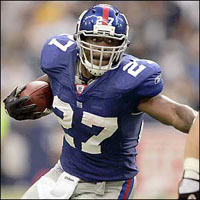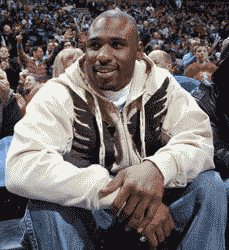CONTENTS
Tulsa's Golden Years
Emlen Tunnell
No Tangerines for Bulls
Saints Get Moore from Lance
Lopsided Series
The A-11 Formation
Los Angeles Bulldogs
From Troubled Youth to Super Bowl
One-Time-Only Bowls
1974 - A Lousy Year for QBs
Football:
Did You Know? I
Football: Did You
Know? II
Football: Did You
Know? III
Football: Did You
Know? IV
Football: Did You
Know? V
Football: Did You
Know? VII
Football Magazine
Golden Rankings Home
Top of Page |
Football:
Did You Know? – VI
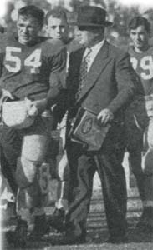 Henry Frnka
Henry Frnka
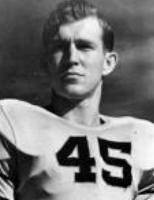
Glenn Dobbs
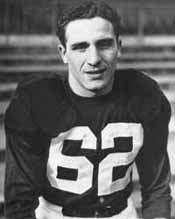
Charley Trippi
|
Tulsa University played in five straight New Year's Day bowls from 1941-5. Those years corresponded to the tenure of Henry Frnka as head coach.
- 1941: Tulsa finished 7-2, including victories over Oklahoma A&M and Baylor. The losses were to TCU and Arkansas. The Golden Hurricanes beat Texas Tech 6-0 in the Sun Bowl in El Paso TX on January 1, 1942. TB Glenn Dobbs passed for 239y, including the game's only score, a 32y TD to E Saxon Judd.
- 1942: Frnka's second team went 10-0, defeating Oklahoma, Oklahoma A&M, Baylor, and Arkansas. They didn't allow a point until their seventh game and ended with seven shutouts. Tulsa led the nation in both scoring (42.7ppg) and scoring D (3.2ppg). They faced 8-1-1 Tennessee in the Sugar Bowl. Dobbs completed seven straight passes in Q2, the last a 9y TD to Cal Purdin to break a scoreless tie. The Vols came right back but missed the PAT to trail 7-6 at halftime. Early in Q3, a blocked punt resulted in a safety to give the Vols an 8-7 lead. An INT a short time later resulted in a 1y TD run and a 14-7 Tennessee victory.
- 1943: Frnka had only six returning members from the 1942 squad. 24 of the 40-man squad were classifed 4-F or had medical discharges. Another nine were 18 or younger. The team included one-armed G Ellis Jones, who made all-Missouri Valley Conference nonetheless, a player with only one lung, and another with only one kidney. HB Camp Wilson had to wear a special shoe because of a severed Achilles tendon. Playing an abbreviated wartime schedule, Tulsa finished 5-0-1, the tie coming to lowly Southwestern 6-6. The Sugar Bowl wanted to invite #2 Iowa Pre-Flight, but the Navy's 48-hour furlough limit made it impossible for the Seahawks to play in a bowl. So the committee invited the #15 Hurricanes again. This time the opponent was #18 Georgia Tech. This made Tech the first school to participate in all four major bowls (Rose, Orange, Cotton, and Sugar). A TD pass on a fake FG helped Tulsa take n 18-7 halftime lead. However, Tech rallied for two second half TDs to pull out a 20-18 victory, with successful PATs kicked by E Phil Tinsley providing the margin of victory.
- 1944: The 7-2 season, including victories over Kansas, Texas Tech, Ole Miss, Arkansas, and Miami (FL), led to a #17 ranking for the Hurricanes. Frnka's fourth team led the nation in total offense and passing. Their reward was a rematch with Georgia Tech, this time in the Orange Bowl. Tulsa took a 14-0 Q1 lead on two TDs by WB Ed Schelosky. A 65y pass-lateral from Perry Moss to Shedlosky to Barney White made the score 20-0 in Q3. This time Tech could not come back despite the heroics of future coach, AD, and TV commentator Frank Broyles, who passed for 304y. He threw a 51y TD pass to close the gap to 20-6. But Camp Wilson returned the ensuing kickoff 90y to seal the 26-12 victory.
- 1945: Frnka's last Tulsa team won 8 and lost 2 to once again finished 17th in the final AP poll. The vanquised included Texas Tech, Baylor, and Arkansas. The losses were road games at Indiana and Oklahoma A&M. This time they were invited to the brand new Oil Bowl in Houston to face #18 Georgia. The Bulldogs won an exciting game, 20-6. TB Charley Trippi scored on a 68y punt return and threw a 64y TD.
Frnka moved to Tulane after the 1945 season. There he compiled a 31-23-4 record through 1951. His 1948 team finished 9-1, the only defeat coming on the road at Georgia Tech, but did not go to a bowl. His '49 squad was upset by LSU in the finale, 21-0, to knock them out of the Sugar Bowl. Frnka retired after 1951 as the school's administration decided to deemphasize football.
|
|
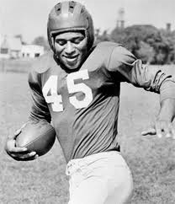
Emlen Tunnell
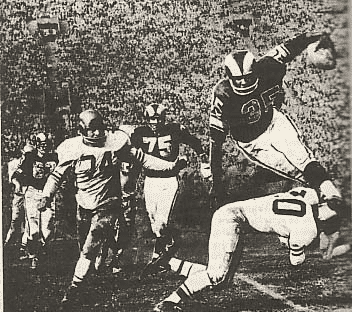
Dan Towler
|
In 1952, Emlen Tunnell, New York Giants S, gained more yards on interception and kick returns than the NFL's leading rusher gained from scrimmage.
Emlen Tunnell
Punt returns: 411 yds
Kickoff returns: 364 yds
Interception returns: 149 yds
Total: 924 yds
|
Leading Rusher
Dan Towler, LA Rams
894 yds
|
- During his career from 1948-1962 (the last three seasons with the Packers), Tunnell intercepted 79 passes, a record later broken by Paul Krause (1964-1979) by two.
- Undrafted out of Iowa, primarily because the league shunned most black players, he walked into the Giants' front office in 1948 and offered his services. He thus became the first African-American to play for the Giants.
- 6'1", 187 lb, "Em" redefined the S position in the NFL. The key "strut" in the Giants' famed "Umbrella Defense," he made the Pro Bowl nine times and was first team All-Pro four times.
- His first few seasons in New York, his fellow S was another future Hall of Famer (as a coach), Tom Landry, a Southerner from Texas. In the famous 1958 Championship Game against the Colts, Tunnell's S companion was Jimmy Patton, another Southerner from Ole Miss.
- Emlen was inducted into the NFL Hall of Fame in 1968.
|
|
By winning the Eastern Division of the Mid-American Conference in 2008, Buffalo University earned a bowl bid, the second in 102 years of playing football. However, this time the Bulls will accept the invitation. Fifty years earlier, the team decided to reject the post-season bid it was offered.
- The 1958 Bulls won 8 of 9 games and received the Lambert Cup as the best small college football team in the East. The team received an invitation to face Florida State in the 13th annual Tangerine Bowl in Orlando FL.
- However, the team's elation was soon dampened when they found out that the Bulls' two African-American players, starting HB Willie Evans and reserve DE Mike Wilson, would not be allowed to participate in the game.
- The proviso came from the Orlando High School Athletic Association, owners of the stadium in which the game would be played. The Association's rules prohibited integrated contests. Despite protests from the Orlando Elks Lodge, sponsors of the Tangerine Bowl, the Association would not budge.
- Buffalo coach Dick Offenhamer let the team decide whether to play in the game. Even before ballots could be passed out at the meeting, the players unanimously rejected the Tangerine Bowl's invitation. "We weren't the same team without Willie and Mike," G Phil Bamford remembers. "Whether they were benchwarmers or stars, we wouldn't have been the same team."
- Florida State also pulled out of the Orlando game and played Oklahoma State in the Bluegrass Bowl in Louisville. OSU won 15-6 in the only Bluegrass Bowl every played.
- The 1958 Tangerine Bowl pitted East Texas State against Missouri Valley with ETSU prevailing 26-7.
Members of the 1958 Bulls returned to campus to be honored at homecoming 2008. Coach Turner Gill, who, like AD Warde Manuel (from New Orleans), is African-American, asked Willie Evans to speak to the current team. Evans says that, try as he might, he cannot remember the crucial meeting when his teammates to a man rallied around him and Wilson.
Reference: "All or Nothing," ESPN Outside the Lines
|
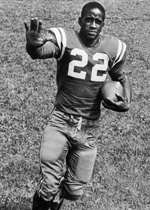
Willie Evans
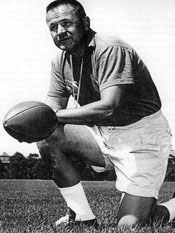
Dick Offenhamer
|
|
|
Lopsided Series
You probably know that, in 2007, Navy broke its 43-game losing streak to Notre Dame, which was the longest drought at that time. What now qualifies the longest losing streak to a single opponent?
- The new longest streak is Kentucky against Tennessee. The Wildcats have not beaten the Vols since 1984 (17-12 at Knoxville, no less). Through the 2008 season, that's 24 straight losses and counting. [The Wildcats finally ended the string in 2011.]
- Amazingly, Kentucky also boasts (?) the second longest extant losing streak to an opponent: 22 straight to Florida. UK last defeated the Gators 10-3 in Lexington in 1986. These two streaks are revenge by the SEC for the many long winning streaks the Cats compiled in basketball over the decades.
- Going back to its days as the Big 8, the Big 12 has seen some long winning streaks.
- Until Kansas won 40-15 in Lawrence in 2005, Nebraska had defeated the Jayhawks 37 straight times. The last KU win had been in 1968, 23-13 in Lincoln. In between the two wins were some monumental drubbings by the Cornhuskers: 70-0, 67-13, 54-2, 63-10.
- Starting in 1937, Oklahoma defeated Kansas State 32 consecutive seasons. During the 15 years from 1948-1962, OU shut out the Wildcats ten times, outscoring them 584-32. Ouch! When K-State ended the streak, they did it with a flourish: 59-21 in 1969.
- Nebraska compiled another streak of dominance in its conference. When NU fell to Missouri in 1978 one week after beating #1 Oklahoma, the loss ruined the Huskers' national championship hopes. So Nebraska punished the Tigers by beating them 24 straight times until Mizzou finally prevailed 41-24 in 2003. One of Missouri's losses during the streak was the famous 1997 game in which NU tied the score in the last seconds on a pass that bounced off the foot of a receiver.
Reference: Football's Most Wanted II, Walter Harvey
|
Have you heard of the A-11 formation? It started in 2007 at Piedmont HS in California and is starting to spread to other areas.
- The formation takes advantage of a loophole in the high school rules when the offensive team lines up in "scrimmage-kick formation," which is traditionally used for punts and FGs. As long as the player receiving the snap is seven yards behind center, any teammate wearing the jersey of an eligible receiver (1-40, 80-89) may go downfield.
- Piedmont O coordinator Steve Humphries conceived the idea of passing and running out of the scrimmage-kick formation. He has also added the wrinkle of putting two QBs behind the C. Kurt Bryan, Piedmont's head coach, has written: "We borrowed some of the basic concepts of the Spread, added elements of the Run-n-Shoot, Navy's Triple Option, some steps and sight adjustment reads of the West Coast and other offenses similar to it, then we morphed it into a complete package."
- The formation requires every player to be able to catch, run and block and is therefore lauded for reversing the trend toward more and more specialization. The A-11 requires a different type of O lineman. Piedmont sends its big uglies to a martial arts coach to help prepare them.
- Piedmont got approval for the offense from the National Federation of State High School Associations and the California Interscholastic Federation. However, several states have banned the A-11, calling it deceptive and unsporting.
- Many wonder if the A-11 will graduate to college. Texas Tech's Mike Leach, the spread O guru, says, "They really have some good ideas that I think ought to be looked at." NCAA rules make the scrimmage-kick formation legal only when the D might reasonably expect a kick – whatever that means.
- Don't expect A-11 in the NFL any time soon. The formation violates the NFL's rule that there must be five ineligible players on the line wearing numbers between 50 and 79. There's no scrimmage kick exception.
|
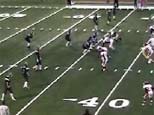
A-11 Formation
Click here for a picture from the 2008 Florida-LSU game |
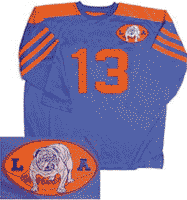

Elmer "Gloomy Gus" Henderson
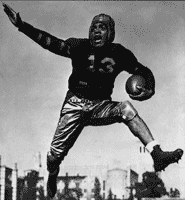
Kenny Washington
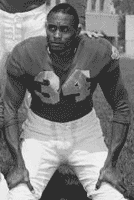
Woody Strode
|
The Los Angeles Bulldogs were a professional football team that was formed in 1936 with the express purpose of joining the NFL, which agreed to grant the team "probationary status" for one season. Interestingly, the Bulldogs were owned by the local chapter of the American Legion which hired Harry Meyers as GM and allocated $10,000 for hiring players. As head coach, Meyers signed Gus Henderson who had coached USC (1919-1924) and Tulsa (1925-1935).
The Bulldogs signed several former NFL players: Ray Richard, a lineman from the Chicago Bears, E Ike Frankien of the New York Giants, and 5'6" 155 lb Gil Lefebvre, who had set the league record with an 89yd punt return for the Detroit Lions in 1933. Henderson also corraled four of his former Tulsa players: Roy Berry, Hal Wickersham, Frank Greene, and Homer Reynolds.
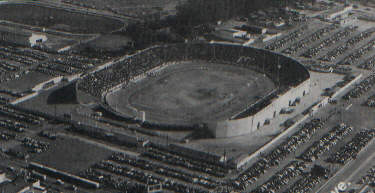 Gilmore Stadium, Los Angeles
Gilmore Stadium, Los AngelesWhile the NFL had often included "traveling teams," such as the 1927 Duluth Eskimos (the inspiration for the movie "Leatherheads"), that played all their games on the road, the Bulldogs played all their games at 18,000-seat Gilmore Stadium. In addition to defeating area teams like the Salinas Packers and Hollywood Stars, the 1936 Bulldogs also played six of the nine NFL teams.
- Defeated the Philadelphia Eagles 10-7.
- Beat the Pittsburgh Pirates 21-7.
- Edged the Chicago Cardinals 13-10.
- Tied the Brooklyn Dodgers 13-13.
- Lost to the Chicago Bears 7-0.
- Got clobbered 49-0 by the Green Bay Packers, who would go on to win the 1936 NFL Championship.
The games against the Bulldogs were exhibition games that did not count in the standings. Yet they drew an average of 9,400 fans for the season and as many as 12,000 for the second half of the campaign. Despite the Bulldogs' good showing on the field and at the box office, the NFL decided to accept the Cleveland Rams, who had played in the American Football League in 1936, into the league for 1937.
Undaunted, the Bulldogs joined the AFL in place of the Rams. 1937 saw Los Angeles become the first pro football team to complete a season undefeated and untied. LA won all eight games against the Rochester Tigers, New York Yankees, Cincinnati Bengals, Boston Shamrocks, and Pittsburgh Americans. Drawing 14,000 fans a game, the Bulldogs were the only team in the league to make a profit. As a result, the AFL shut down before the 1938 season, and the Bulldogs reverted to the independent status they enjoyed in 1936. Now coached by Frankien, Los Angeles compiled a 2-1-2 record against NFL teams in 1938.
For 1939, the Bulldogs and the Cincinnati Bengals, who had also played as an independent in 1938, joined a reincarnation of the AFL, this time called the American Professional Football League. LA (7-1) and Cincy (6-2) dominated over the Columbus Bullies, Chicago Indians, St. Louis Gunners, Dayton Bombers, Kenosha (WI) Cardinals, and Louisville Tanks. Despite the fact that the Bulldogs had the best winning percentage (.875), Columbus was declared the league champion because it had 9 wins against 2 losses.
1940 saw the Bulldogs join yet another league ? the brand new Pacific Coast Professional Football League. The Bulldogs were the only team to compete every year of the PCPFL's existence before its demise after the 1948 season. Frankien was the head coach throughout as Los Angeles won the championship in 1940 and 1946. The PCPFL showcased African-American stars such as former UCLA teammates Kenny Washington and Woody Strode who were shunned by the NFL.
Although it stayed strong throughout World War II, the PCPFL was mortally wounded when the NFL's Cleveland Rams moved to Los Angeles for the 1946 season, the same year that the Los Angeles Dons began play in the new All-America Football Conference.
|
|
From Troubled Youth to Super Bowl
New York Giants RB Brandon Jacobs grew up in Napoleonville LA, a small town of 700 on Bayou Lafourche about 60 miles west of New Orleans. As late as his junior year of high school, no one would have predicted that he had any future in football.
- As a boy, Brandon had a bad temper and frequently got into fights. As a result, he was placed in special education classes that would lead only to a certificate of achievement and not a high school diploma.
- By age 11, Jacobs moved in with an aunt who cracked down on his unacceptable behavior and instead pointed him to football in hopes that it would instill discipline into his life.
- His freshman year at Assumption High, Brandon, already much larger than his peers, was promoted to the varsity. But he soon quit because he was dissatisfied with his playing time and thought it was just too hot and humid for football. Anyway, he thought he was a better at basketball.
- Coach Don Torres, who regretted putting the immature freshman on the varsity, kept after Brandon until he returned to the team for his junior year. After Assumption began the seson with three defeats, Torres switched Jacobs from FB to TB. The Mustangs won seven straight games, and he received his first recruiting letter ? from Georgia. "I could see that I could be heading somewhere in my life," he says of the life-changing experience.
- As a senior in 2000, Brandon carried the ball 35-40 times a game to lead Louisiana with 3,025y rushing. Assumption won 13 in a run before losing to perennial power John Curtis in the state semifinals.
- Brandon had transferred from special ed to a mainstream curriculum. However, he didn't have enough time to amass the credits needed to enter a major college. Auburn proposed that he enter Coffeyville Community College in Kansas to gain enough credits to qualify for a four-year college.
- Jacobs entered Auburn in 2003 only to find himself third string behind two future first-round draft picks, Ronnie Brown and Carnell Williams. So he transferred to Southern Illinois, where he played enough to be picked in the fourth round by the Giants in 2005.
- Brandon's aunt still rides herd on him when needed. After he jawed with a Steelers player during the 2008 season, his aunt and his mother attended the next game at Giants Stadium. As he drove them from the airport, his aunt swatted him in the head. "Don't you ever let me see that again!" He behaved himself the next game, except when he tossed his mother the ball after scoring a TD in a 35-14 lambasting of Dallas.
|
|
Reference: "No Giving Up," Jere Longman, The New York Times, December 24, 2008
|
|
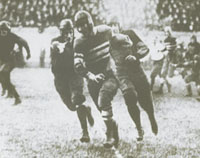 Bo McMillin
Bo McMillin

Los Angeles Christmas Classic 1924

|
Some bowl games didn't last long. In fact, these were played just once.
- Way back on January 1, 1921, the Fort Worth Classic matched Centre College (KY) against TCU. Centre walloped the home-standing Horned Frogs 63-7 behind sensational HB Bo McMillin. Despite a good crowd of 9,000, the "Classic" was never played again.
- Los Angeles, already blessed with the Rose Bowl in Pasadena, staged the Los Angeles Christmas Festival on December 25, 1924. 47,000 saw Southern Cal defeat Missouri 20-7 in the Coliseum, which had opened in 1923.
- The current Alamo Bowl in San Antonio had a predecessor on January 4, 1947, when Hardin-Simmons defeated Denver 20-0 before 3,730 in Alamo Stadium. The lack of attendance doomed the bowl to failure.
- On December 6, 1947, Kentucky defeated Villanova 24-14 in the Great Lakes Bowl at Cleveland. 14,908 were dwarfed in massive Municipal Stadium. The victorious Wildcat coach was none other than Bear Bryant. His QB was George Blanda.
- Little Rock AK hosted the Shrine Bowl on December 18, 1948, in War Memorial Stadium. 5,000 watched as Hardin-Simmons blasted Ouachita Baptist 40-12.
- Twelve days later, Hardin-Simmons walloped Wichita State 49-12 in the only incarnation of the Camellia Bowl in Lafayette LA on December 30, 1948 before 4,500 spectators.
- Texas A&M and Georgia competed for the Presidential Cup on December 9, 1950, at Byrd Stadium in College Park MD. The Aggies prevailed 40-20 in front of 12,245.
- The Bluegrass Bowl pitted Oklahoma State and Florida State on December 13, 1958 at Louisville's Fairgrounds Stadium. With both teams wearing sneakers on the icy field, OSU won 15-6 before an announced crowd of 7,000 but probably only about 3,000 in the sub-zero temperatures. ABC televised the game, but when the network announced it wasn't interested in doing it again, the bowl folded.
- Thanksgiving Day (November 23), 1961. Fresno State shellacked Bowling Green 36-6 in the Mercy Bowl in the LA Memorial Coliseum before 33,145. The game was organized with the support of comedian Bob Hope and the blessing of President John F. Kennedy to raise money for the families of the 22 members of the Cal Poly team who were killed in the crash of their plane in 1960. This "bowl" was never intended to be held more than once.
|
1974 - A Lousy Year for QBs
The 1974 NFL draft was the first one since 1947 in which no QB was taken in the first round.
- In fact, there was no signal-caller chosen in Round 2 that year either.
- The first QB to go off the board was Danny White of Arizona State, taken by Dallas with the first pick in Round 3.
- Next was David Jaynes of Kansas, who went to Kansas City with the 14th pick of Round 3.
- Later in that round, Atlanta and Buffalo chose QBs back-to-back, Kim McQuilken of Lehigh and Gary Marangi of Boston College (in that order).
- The fourth round produced these QB choices:
New York Giants - Carl Summerell, East Carolina (#80 overall, two picks ahead of Hall of Fame WR John Stallworth)
Cincinnati Bengals - Mike Boryla, Stanford
Los Angeles Rams - Norris Weese, Ole Miss (Chalmette LA)
- Round 6:
San Diego Chargers - Jesse Freitas, San Diego State
- Round 8:
Chicago Bears - Alan Chadwick, East Tennessee State
Buffalo - Gregg Hare, Ohio State
- Round 10:
Miami - Gary Valbuena, Tennessee
- Round 12:
Baltimore Colts - Bo Bobrowski, Purdue
Dallas - Keith Bobo, SMU
- Round 13
Chicago - Joe Barnes, Texas Tech
San Francisco - Tom Owen, Wichita State
Pittsburgh - Frank Kolch, Eastern Michigan
- Round 14: Washington - Don Van Galder, Utah
- Round 15:
New Orleans - Larry Cipa, Michigan
Denver - Piel Pennington, Massachusetts
- Round 17:
Chicago - Craig Holland, Texas-Arlington
- Supplemental Draft (only pick)
Cincinnati: Clint Longley, Abilene Christian
The table below shows that the only 1974 QB draftee who amounted to anything was the first one chosen, Danny White, who played 13 years for the Cowboys (after two years in the World Football League).
Career Statistics of QBs Chosen in 1974 NFL Draft
| Player |
Teams |
Years |
G |
Comp. |
Att. |
Yds |
TD |
Int |
| Danny White |
Dallas |
1976-88 |
166 |
1,761 |
2,950 |
21,959 |
155 |
132 |
| David Jaynes |
Kansas City |
1974 |
2 |
0 |
2 |
0 |
0 |
1 |
| Kim McQuilken |
Atlanta, Washington |
1974-77, 1979 |
26 |
108 |
272 |
1135 |
4 |
29 |
| Gary Marangi |
Buffalo |
1974-76 |
19 |
104 |
283 |
1373 |
12 |
21 |
| Carl Summerell |
NY Giants |
1974-75 |
10 |
13 |
29 |
157 |
0 |
5 |
| Mike Boryla |
Phila, Tampa Bay |
1974-76, 1978 |
23 |
272 |
519 |
2,838 |
20 |
29 |
| Norris Weese |
Denver |
1976-79 |
57 |
143 |
251 |
1,887 |
7 |
14 |
| Jesse Freitas |
San Diego |
1974-75 |
13 |
98 |
219 |
1,244 |
8 |
13 |
| Joe Barnes |
Chicago |
1974 |
3 |
2 |
9 |
29 |
0 |
1 |
| Tom Owen |
San Fran, New Eng |
1974-79, 1981 |
26 |
170 |
349 |
2,300 |
14 |
26 |
| Larry Cipa |
New Orleans |
1974-75 |
8 |
34 |
92 |
424 |
1 |
3 |
| Clint Longley |
Dallas, San Diego |
1974-76 |
9 |
31 |
68 |
441 |
5 |
4 |
The next year in which no QB was taken in the first round was 1984. But that draft included some good ones.
- 2nd round:
Cincinnati:
Boomer Esiason, Maryland
- 11th round:
Tampa Bay: Steve Young, Brigham Young (taken so low because he was playing in the USFL)
The following year, 1985, also saw no signal-callers selected in the opening round, but several who forged fine careers were taken later.
- 2nd round:
Philadelphia: Randall Cunningham, UNLV
- 3rd round:
Buffalo: Frank Reich, Maryland
- 11th round:
Los Angeles Rams: Doug Flutie, Boston College
Cleveland: Bernie Kosar, Miami (FL)
In 1988, no team selected a QB until Indianapolis took Chris Chandler of Washington in Round 3.
The 1996 draft included no QBs until the second round and none of the six chosen had much success.
Every draft since (through 2015) has seen a QB chosen in Round 1. |
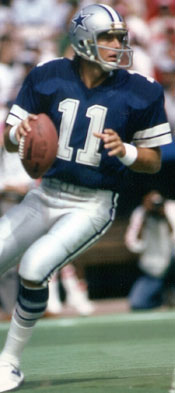
Danny White

Boomer Esiason
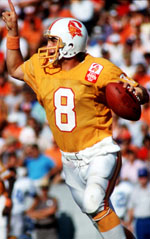
Steve Young
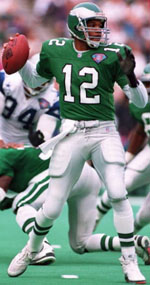
Randall Cunningham
|
|
|













